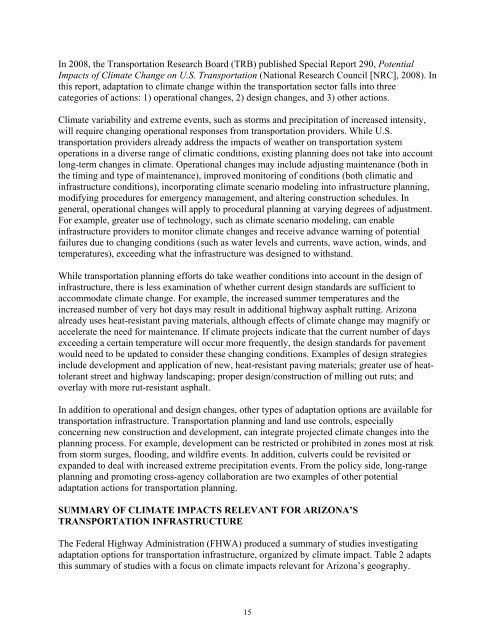SPR-696: Preliminary Study of Climate Adaptation for the Statewide ...
SPR-696: Preliminary Study of Climate Adaptation for the Statewide ...
SPR-696: Preliminary Study of Climate Adaptation for the Statewide ...
You also want an ePaper? Increase the reach of your titles
YUMPU automatically turns print PDFs into web optimized ePapers that Google loves.
In 2008, <strong>the</strong> Transportation Research Board (TRB) published Special Report 290, PotentialImpacts <strong>of</strong> <strong>Climate</strong> Change on U.S. Transportation (National Research Council [NRC], 2008). Inthis report, adaptation to climate change within <strong>the</strong> transportation sector falls into threecategories <strong>of</strong> actions: 1) operational changes, 2) design changes, and 3) o<strong>the</strong>r actions.<strong>Climate</strong> variability and extreme events, such as storms and precipitation <strong>of</strong> increased intensity,will require changing operational responses from transportation providers. While U.S.transportation providers already address <strong>the</strong> impacts <strong>of</strong> wea<strong>the</strong>r on transportation systemoperations in a diverse range <strong>of</strong> climatic conditions, existing planning does not take into accountlong-term changes in climate. Operational changes may include adjusting maintenance (both in<strong>the</strong> timing and type <strong>of</strong> maintenance), improved monitoring <strong>of</strong> conditions (both climatic andinfrastructure conditions), incorporating climate scenario modeling into infrastructure planning,modifying procedures <strong>for</strong> emergency management, and altering construction schedules. Ingeneral, operational changes will apply to procedural planning at varying degrees <strong>of</strong> adjustment.For example, greater use <strong>of</strong> technology, such as climate scenario modeling, can enableinfrastructure providers to monitor climate changes and receive advance warning <strong>of</strong> potentialfailures due to changing conditions (such as water levels and currents, wave action, winds, andtemperatures), exceeding what <strong>the</strong> infrastructure was designed to withstand.While transportation planning ef<strong>for</strong>ts do take wea<strong>the</strong>r conditions into account in <strong>the</strong> design <strong>of</strong>infrastructure, <strong>the</strong>re is less examination <strong>of</strong> whe<strong>the</strong>r current design standards are sufficient toaccommodate climate change. For example, <strong>the</strong> increased summer temperatures and <strong>the</strong>increased number <strong>of</strong> very hot days may result in additional highway asphalt rutting. Arizonaalready uses heat-resistant paving materials, although effects <strong>of</strong> climate change may magnify oraccelerate <strong>the</strong> need <strong>for</strong> maintenance. If climate projects indicate that <strong>the</strong> current number <strong>of</strong> daysexceeding a certain temperature will occur more frequently, <strong>the</strong> design standards <strong>for</strong> pavementwould need to be updated to consider <strong>the</strong>se changing conditions. Examples <strong>of</strong> design strategiesinclude development and application <strong>of</strong> new, heat-resistant paving materials; greater use <strong>of</strong> heattolerantstreet and highway landscaping; proper design/construction <strong>of</strong> milling out ruts; andoverlay with more rut-resistant asphalt.In addition to operational and design changes, o<strong>the</strong>r types <strong>of</strong> adaptation options are available <strong>for</strong>transportation infrastructure. Transportation planning and land use controls, especiallyconcerning new construction and development, can integrate projected climate changes into <strong>the</strong>planning process. For example, development can be restricted or prohibited in zones most at riskfrom storm surges, flooding, and wildfire events. In addition, culverts could be revisited orexpanded to deal with increased extreme precipitation events. From <strong>the</strong> policy side, long-rangeplanning and promoting cross-agency collaboration are two examples <strong>of</strong> o<strong>the</strong>r potentialadaptation actions <strong>for</strong> transportation planning.SUMMARY OF CLIMATE IMPACTS RELEVANT FOR ARIZONA’STRANSPORTATION INFRASTRUCTUREThe Federal Highway Administration (FHWA) produced a summary <strong>of</strong> studies investigatingadaptation options <strong>for</strong> transportation infrastructure, organized by climate impact. Table 2 adaptsthis summary <strong>of</strong> studies with a focus on climate impacts relevant <strong>for</strong> Arizona’s geography.15
















